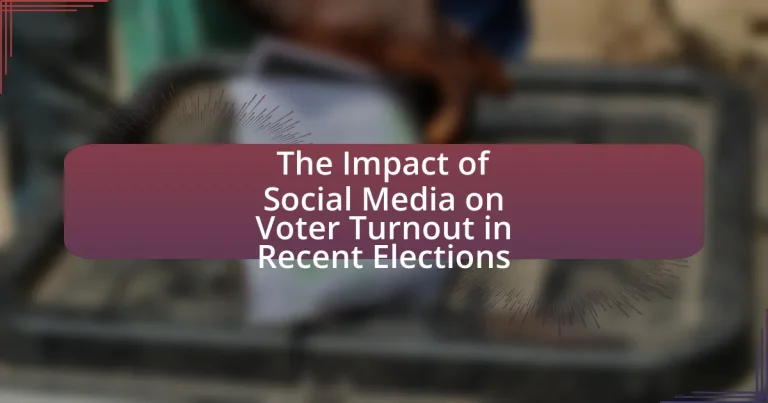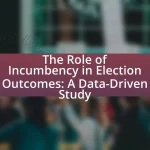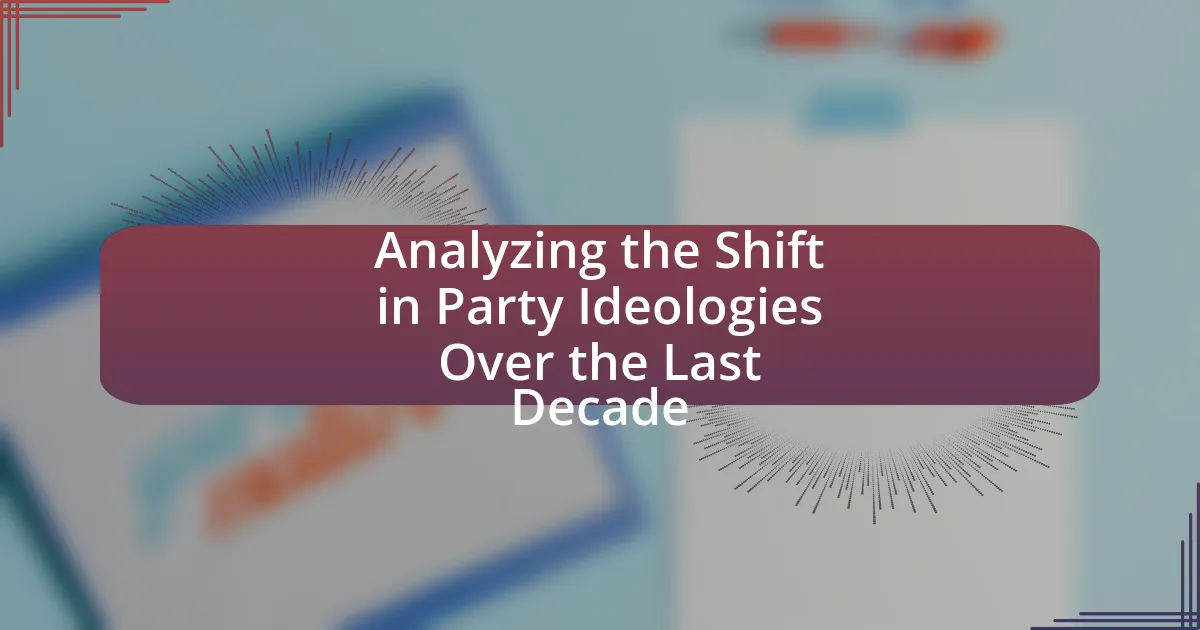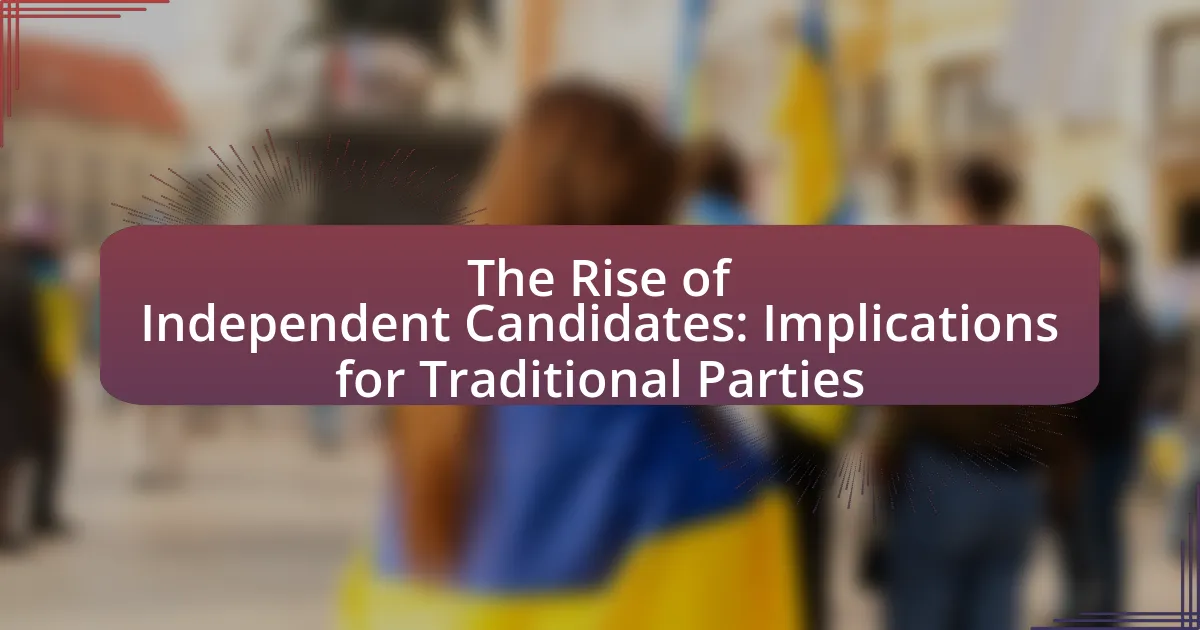The article examines the impact of social media on voter turnout in recent elections, highlighting its role in enhancing engagement, particularly among younger demographics. It discusses how platforms like Facebook and Twitter facilitate political discussions, provide essential voting information, and encourage electoral participation. Key findings indicate that social media significantly influences voter perceptions and decisions, with studies showing that a substantial percentage of users report being more likely to vote due to information encountered online. Additionally, the article addresses the challenges posed by misinformation and polarization on social media, as well as strategies to enhance its positive effects on voter mobilization.
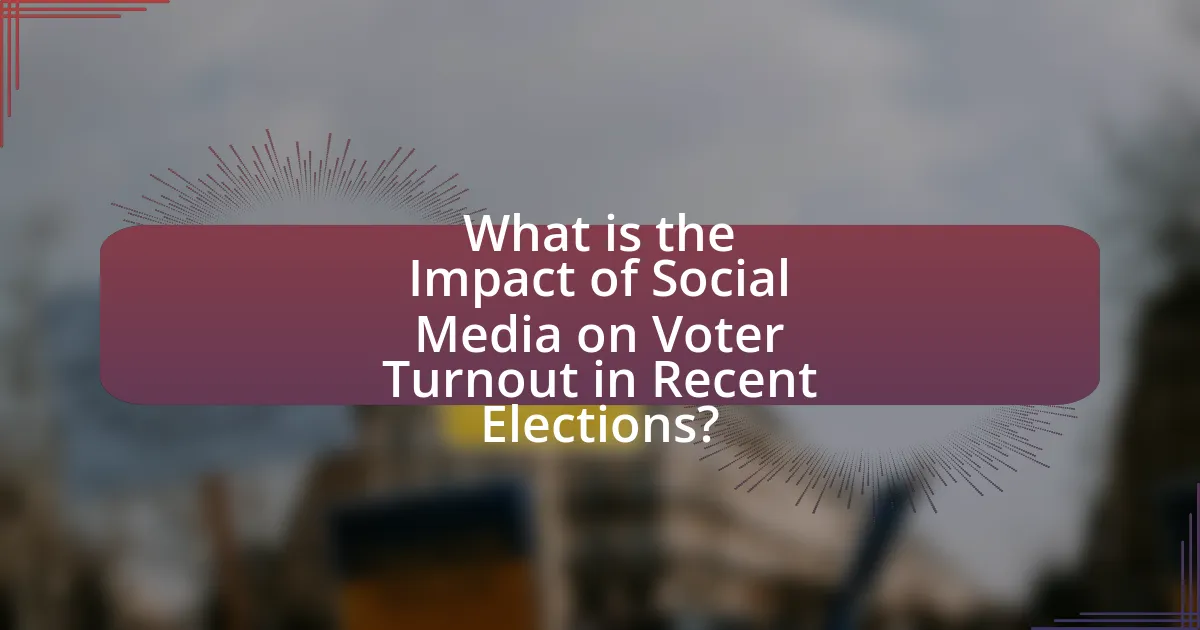
What is the Impact of Social Media on Voter Turnout in Recent Elections?
Social media significantly increases voter turnout in recent elections by enhancing engagement and mobilizing younger demographics. Studies indicate that platforms like Facebook and Twitter facilitate political discussions, provide information about voting procedures, and encourage users to participate in elections. For instance, a study by the Pew Research Center found that 50% of social media users reported being more likely to vote due to information encountered on these platforms. Additionally, targeted ads and reminders on social media have proven effective in reaching potential voters, particularly among millennials and Gen Z, who are more active online. This trend demonstrates that social media serves as a crucial tool for increasing electoral participation.
How has social media changed the landscape of political engagement?
Social media has transformed political engagement by enabling direct communication between politicians and the electorate, fostering greater participation and mobilization. Platforms like Twitter and Facebook allow candidates to share their messages instantly, bypassing traditional media filters, which has led to increased voter awareness and involvement. For instance, during the 2016 U.S. presidential election, 62% of voters reported that social media influenced their political views, according to the Pew Research Center. This shift has also facilitated grassroots movements, as seen in the Arab Spring, where social media played a crucial role in organizing protests and spreading information rapidly.
What role does social media play in informing voters?
Social media plays a crucial role in informing voters by providing a platform for the dissemination of political information, candidate positions, and electoral updates. It enables users to access diverse viewpoints and engage in discussions, which can enhance their understanding of issues and candidates. According to a Pew Research Center study, 53% of voters reported that social media influenced their voting decisions in the 2020 U.S. presidential election, highlighting its significant impact on voter awareness and engagement.
How does social media influence voter perceptions and opinions?
Social media significantly influences voter perceptions and opinions by shaping the information landscape and facilitating engagement. Platforms like Facebook and Twitter allow users to access diverse viewpoints, which can alter their understanding of political issues and candidates. Research indicates that 64% of voters reported that social media influenced their voting decisions in the 2020 U.S. elections, highlighting its role in shaping public opinion. Additionally, social media enables targeted political advertising, which can reinforce existing beliefs or sway undecided voters, further impacting electoral outcomes.
Why is voter turnout important in elections?
Voter turnout is important in elections because it directly influences the legitimacy and representativeness of the electoral outcome. High voter turnout indicates that a larger segment of the population is engaged in the democratic process, which enhances the credibility of the elected officials and the policies they implement. For instance, in the 2020 U.S. presidential election, voter turnout reached approximately 66.8%, the highest rate for a presidential election since 1900, reflecting increased public engagement and interest in the electoral process. This engagement can be significantly impacted by social media, which serves as a platform for mobilizing voters and disseminating information about the voting process.
What are the consequences of low voter turnout?
Low voter turnout leads to a lack of representation in government, as decisions may be made by a small, unrepresentative segment of the population. This can result in policies that do not reflect the needs or desires of the broader community. For instance, in the 2016 U.S. presidential election, approximately 58% of eligible voters participated, meaning nearly half of the population did not have a say in the outcome, potentially skewing policy priorities. Additionally, low turnout can diminish the legitimacy of elected officials, as they may be perceived as lacking a mandate from the electorate, which can erode public trust in democratic institutions.
How does voter turnout affect election outcomes?
Voter turnout significantly affects election outcomes by determining which candidates or measures are elected. Higher voter turnout often favors candidates who appeal to a broader demographic, while lower turnout can lead to victories for candidates with more niche support. For instance, in the 2008 U.S. presidential election, a turnout of approximately 61.6% contributed to Barack Obama’s victory, as he mobilized younger voters and minorities, demographics that typically have lower turnout rates. Conversely, in the 2014 midterm elections, a turnout of about 36.4% resulted in significant Republican gains, as their base was more motivated to vote. This illustrates that turnout levels can shift the balance of power in elections, influencing policy direction and governance.
What factors contribute to the impact of social media on voter turnout?
The factors that contribute to the impact of social media on voter turnout include the ability to disseminate information rapidly, the facilitation of political engagement, and the influence of social networks. Social media platforms enable campaigns to share information about candidates and issues quickly, reaching a broad audience and increasing awareness. Additionally, these platforms encourage political discussions and mobilization efforts, making it easier for individuals to engage with the electoral process. Research indicates that social media can significantly enhance voter turnout; for instance, a study by the Pew Research Center found that 69% of social media users reported that they had seen information about the election on these platforms, which correlates with increased voter participation.
How do different social media platforms affect voter engagement?
Different social media platforms significantly affect voter engagement by shaping how information is disseminated and how users interact with political content. For instance, platforms like Facebook and Twitter facilitate direct communication between candidates and voters, leading to increased awareness and participation in elections. A study by the Pew Research Center found that 69% of adults in the U.S. use Facebook, which serves as a primary source of news for many, thus enhancing voter engagement through targeted advertisements and community discussions. Additionally, Instagram’s visual content appeals to younger demographics, encouraging them to engage with political issues through shareable graphics and stories. This multi-platform approach results in varied engagement levels, with younger voters more likely to participate when using platforms that resonate with their communication styles.
What demographic factors influence social media’s effectiveness in mobilizing voters?
Demographic factors such as age, education level, and ethnicity significantly influence social media’s effectiveness in mobilizing voters. Younger individuals, particularly those aged 18 to 29, are more active on platforms like Instagram and TikTok, which can lead to higher engagement and mobilization rates. Research indicates that 50% of young voters reported being influenced by social media in their voting decisions during the 2020 U.S. elections. Additionally, individuals with higher education levels tend to utilize social media for political information, making them more likely to be mobilized through these channels. Ethnic minorities, particularly Black and Hispanic communities, have also shown increased engagement on social media platforms, with targeted campaigns effectively reaching these groups. For instance, a study by the Pew Research Center found that 70% of Black voters used social media to follow political news, highlighting its role in voter mobilization among diverse demographics.
How can we measure the impact of social media on voter turnout?
The impact of social media on voter turnout can be measured through various quantitative and qualitative methods, including surveys, statistical analysis of voting data, and social media engagement metrics. Surveys can assess the influence of social media campaigns on individuals’ likelihood to vote, while statistical analysis can compare voter turnout rates before and after significant social media initiatives. For instance, a study by the Pew Research Center found that 69% of adults in the U.S. reported that social media played a role in their decision to vote in the 2020 election, indicating a direct correlation between social media engagement and increased voter turnout. Additionally, analyzing social media metrics, such as shares, likes, and comments on voter-related content, can provide insights into the effectiveness of outreach efforts.
What metrics are used to assess social media engagement in elections?
Metrics used to assess social media engagement in elections include likes, shares, comments, retweets, and follower growth. These metrics provide quantitative data on how users interact with political content, indicating the level of interest and engagement among the electorate. For instance, a study by the Pew Research Center found that posts with higher engagement rates, such as shares and comments, correlate with increased visibility and influence on voter perceptions. Additionally, sentiment analysis of comments can gauge public opinion and emotional responses to candidates or issues, further informing campaign strategies.
How do surveys and studies quantify social media’s influence on voter behavior?
Surveys and studies quantify social media’s influence on voter behavior by measuring engagement metrics, voter sentiment, and behavioral changes linked to social media exposure. For instance, research conducted by the Pew Research Center indicates that 69% of adults in the U.S. use social media, and among these users, 50% reported that social media influenced their voting decisions in the 2020 election. Additionally, studies often utilize pre- and post-election surveys to assess shifts in voter intentions and turnout, correlating these changes with social media campaigns and messaging. This empirical data provides a clear link between social media activity and voter behavior, demonstrating its significant impact on electoral outcomes.
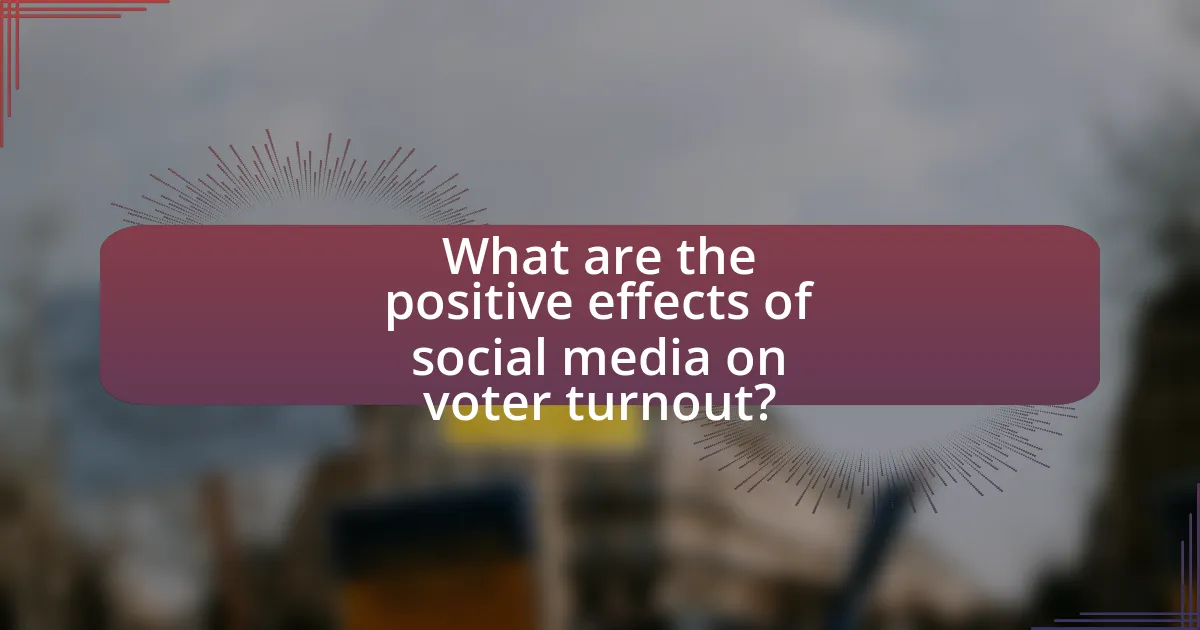
What are the positive effects of social media on voter turnout?
Social media positively affects voter turnout by increasing awareness and engagement among potential voters. Platforms like Facebook and Twitter facilitate the dissemination of information regarding election dates, candidate platforms, and voting procedures, which can lead to higher participation rates. For instance, a study by the Pew Research Center found that 69% of adults in the U.S. use social media, and among those users, 50% reported that social media influenced their decision to vote in the 2020 elections. Additionally, social media campaigns can mobilize younger voters, who are typically less likely to participate in elections, by creating a sense of community and urgency around voting.
How does social media facilitate voter mobilization?
Social media facilitates voter mobilization by providing platforms for information dissemination, community engagement, and direct communication between candidates and voters. These platforms enable campaigns to reach a broad audience quickly, allowing for targeted messaging that resonates with specific demographics. For instance, a study by the Pew Research Center found that 69% of adults in the U.S. use social media, making it a vital tool for reaching potential voters. Additionally, social media encourages grassroots organizing, as users can share events, mobilize friends, and create a sense of urgency around voting, which has been shown to increase turnout rates in various elections.
What campaigns have successfully used social media to increase turnout?
The 2008 Obama campaign successfully used social media to increase voter turnout, leveraging platforms like Facebook and Twitter to engage younger voters. This campaign utilized targeted messaging and grassroots organizing through social media, resulting in a significant increase in voter participation, particularly among first-time voters, with a turnout rate of 66.8% compared to 50.5% in 2004. Additionally, the 2016 Bernie Sanders campaign effectively utilized social media to mobilize supporters, achieving high engagement rates and contributing to a turnout increase among younger demographics. These examples demonstrate the effectiveness of social media in enhancing voter turnout in recent elections.
How do social media events and challenges engage younger voters?
Social media events and challenges engage younger voters by creating interactive and shareable experiences that resonate with their values and interests. These platforms leverage trends and viral content to motivate participation, often using gamification elements that encourage users to take action, such as registering to vote or participating in discussions about political issues. For instance, the #VoteChallenge on platforms like TikTok and Instagram has successfully prompted millions of young users to share their voting plans and encourage peers to do the same, significantly increasing awareness and engagement around elections. Research indicates that social media campaigns can lead to a 10% increase in voter turnout among young demographics, demonstrating their effectiveness in mobilizing this group.
What role does social media play in increasing awareness about voting?
Social media plays a crucial role in increasing awareness about voting by providing a platform for information dissemination and engagement. It enables users to access real-time updates on election dates, candidate platforms, and voting procedures, which enhances public knowledge. For instance, a study by the Pew Research Center found that 69% of adults in the U.S. use social media, and among those, 50% reported that social media influenced their decision to vote. This demonstrates that social media not only informs but also motivates individuals to participate in the electoral process.
How do social media platforms disseminate information about voting procedures?
Social media platforms disseminate information about voting procedures through targeted posts, advertisements, and user-generated content that reach a wide audience. These platforms utilize algorithms to promote content related to voting, ensuring that users receive timely updates about registration deadlines, polling locations, and voting methods. For instance, during the 2020 U.S. presidential election, platforms like Facebook and Twitter implemented features that directed users to official voting resources, significantly increasing awareness and engagement. According to a study by the Pew Research Center, 53% of voters reported that social media played a role in their decision to vote, highlighting the effectiveness of these platforms in informing the electorate.
What impact do influencers have on voter education through social media?
Influencers significantly enhance voter education through social media by disseminating information, mobilizing audiences, and shaping public discourse. Their ability to reach large, engaged followings allows them to share critical information about voting processes, candidate platforms, and election dates, which can lead to increased voter awareness and participation. For instance, a study by the Pew Research Center found that 55% of social media users reported that they encountered political content on these platforms, indicating that influencers play a crucial role in informing their followers about electoral matters. Additionally, influencers often use relatable narratives and personal stories to make complex political issues more accessible, thereby fostering a more informed electorate.
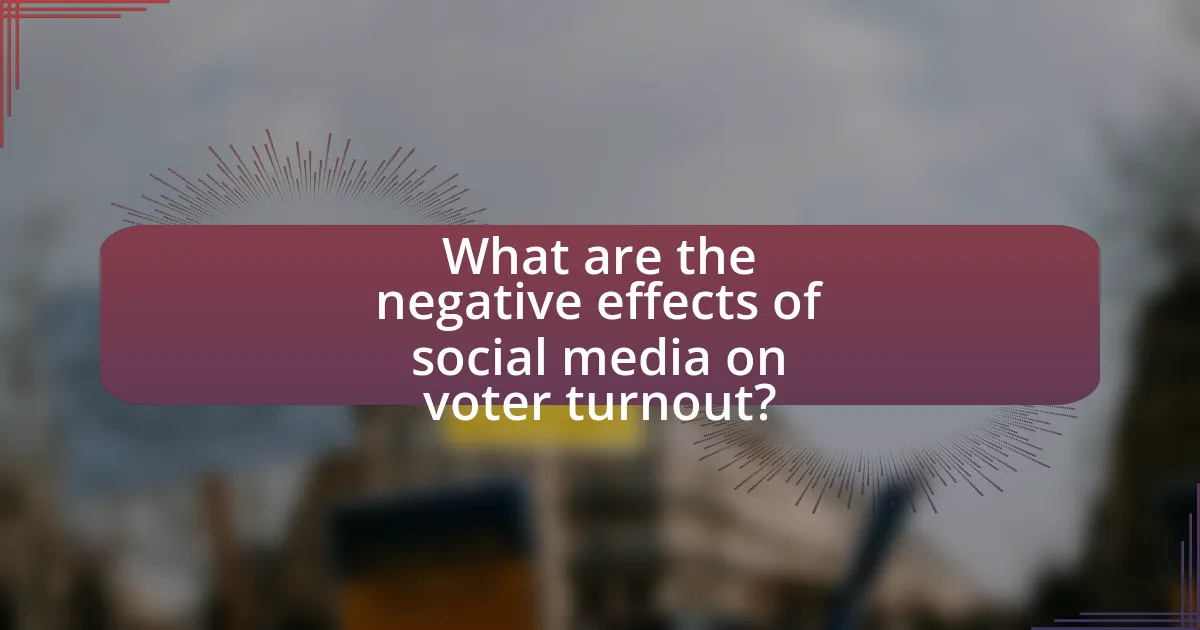
What are the negative effects of social media on voter turnout?
Social media negatively affects voter turnout by fostering misinformation and creating echo chambers. Misinformation can lead to confusion about voting procedures, candidates, and issues, which discourages individuals from participating in elections. For instance, a study by the Pew Research Center found that 64% of Americans believe that false information on social media has caused confusion about the election process. Additionally, echo chambers reinforce existing beliefs, making individuals less likely to engage with differing viewpoints and reducing overall civic engagement. This phenomenon was evident in the 2016 U.S. presidential election, where social media platforms were criticized for amplifying divisive content, ultimately impacting voter mobilization efforts.
How can misinformation on social media affect voter turnout?
Misinformation on social media can significantly decrease voter turnout by creating confusion and distrust among potential voters. Studies indicate that exposure to false information can lead to apathy or disillusionment regarding the electoral process, as individuals may feel their votes do not matter or that the system is rigged. For instance, a 2020 study by the Pew Research Center found that 64% of Americans believed misinformation had a major impact on the election, leading to lower engagement levels. This decline in engagement can result in fewer individuals participating in elections, ultimately affecting the democratic process.
What are the consequences of fake news on electoral participation?
Fake news significantly undermines electoral participation by creating misinformation that can lead to voter apathy and confusion. Studies indicate that exposure to fake news can distort public perception of candidates and issues, ultimately discouraging individuals from voting. For instance, a 2020 study published in the journal “Political Communication” found that misinformation on social media platforms decreased voter turnout by approximately 5% in key demographics. This decline in participation is often attributed to the erosion of trust in the electoral process and the belief that one’s vote may not matter in a landscape filled with misleading information.
How does polarization on social media discourage voter engagement?
Polarization on social media discourages voter engagement by creating echo chambers that reinforce existing beliefs and alienate opposing viewpoints. This environment leads to decreased motivation to participate in elections, as individuals feel their opinions are not represented or valued. Research indicates that highly polarized online interactions can result in lower voter turnout; for instance, a study by the Pew Research Center found that 62% of social media users reported feeling more divided on political issues due to their online experiences. Consequently, this division diminishes the likelihood of individuals engaging in the electoral process, as they may perceive voting as futile in a polarized landscape.
What challenges do campaigns face when using social media?
Campaigns face several challenges when using social media, including misinformation, algorithm changes, and audience engagement. Misinformation can spread rapidly on social platforms, undermining campaign messages and creating confusion among voters. Algorithm changes by social media platforms can limit the visibility of campaign content, making it harder to reach target audiences effectively. Additionally, engaging users in meaningful ways is difficult, as campaigns must compete with a vast amount of content and varying user preferences, which can lead to low interaction rates. These challenges can significantly impact the effectiveness of social media strategies in influencing voter turnout.
How do algorithm changes impact the visibility of political content?
Algorithm changes significantly impact the visibility of political content by altering how such content is prioritized and displayed to users. For instance, platforms like Facebook and Twitter frequently update their algorithms to favor content that generates higher engagement, which can lead to political posts being either amplified or suppressed based on user interactions. A study by the Pew Research Center found that algorithmic adjustments can result in a 50% variation in the reach of political posts, influencing which messages are seen by voters. Consequently, these changes can shape public discourse and voter perceptions, ultimately affecting voter turnout in elections.
What are the risks of over-reliance on social media for voter outreach?
Over-reliance on social media for voter outreach poses several risks, including misinformation, echo chambers, and demographic biases. Misinformation can spread rapidly on social media platforms, leading to confusion among voters about candidates and issues, as evidenced by the 2016 U.S. presidential election, where false information significantly influenced public perception. Echo chambers occur when users are exposed primarily to viewpoints that reinforce their own beliefs, limiting exposure to diverse perspectives and potentially alienating moderate voters. Additionally, demographic biases arise because social media usage varies across age, race, and socioeconomic status, which can result in outreach efforts that fail to engage underrepresented groups, ultimately skewing voter turnout.
What strategies can enhance the positive impact of social media on voter turnout?
Strategies that can enhance the positive impact of social media on voter turnout include targeted messaging, engagement through interactive content, and partnerships with influencers. Targeted messaging ensures that information reaches specific demographics, increasing relevance and resonance; for instance, research by the Pew Research Center indicates that tailored content can significantly boost engagement rates among young voters. Engagement through interactive content, such as polls and quizzes, fosters a sense of community and encourages participation, as evidenced by campaigns that have successfully utilized these tools to increase voter awareness and mobilization. Additionally, partnerships with influencers can amplify reach and credibility, as studies show that endorsements from trusted figures can motivate their followers to participate in elections.
How can campaigns effectively use social media to engage voters?
Campaigns can effectively use social media to engage voters by creating targeted content that resonates with specific demographics. This approach allows campaigns to tailor their messages based on the interests and concerns of different voter groups, increasing the likelihood of engagement. For instance, data from the Pew Research Center indicates that 69% of adults in the U.S. use Facebook, making it a crucial platform for reaching a broad audience. Additionally, campaigns can utilize interactive features such as polls, live Q&A sessions, and shareable graphics to foster two-way communication, which enhances voter involvement and interest. Engaging storytelling and authentic interactions can further strengthen the connection between campaigns and voters, as evidenced by the success of the 2020 U.S. presidential campaigns that effectively leveraged social media to mobilize support and increase voter turnout.
What best practices should organizations follow to combat misinformation?
Organizations should implement a multi-faceted approach to combat misinformation effectively. This includes establishing clear communication channels to disseminate accurate information, training staff on identifying and addressing misinformation, and actively monitoring social media platforms for false narratives. Research indicates that organizations that engage in proactive fact-checking and collaborate with credible fact-checking organizations can significantly reduce the spread of misinformation. For instance, a study by the Pew Research Center found that 64% of Americans believe that social media platforms should take stronger measures to combat misinformation, highlighting the importance of organizational responsibility in this area.
